Birdfinding.info ⇒ One of the most familiar birds in the U.S., especially the southern half, north to the Ohio Valley and mid-Atlantic states, where it is generally abundant in suburban neighborhoods and other semiopen habitats. Also numerous and conspicuous in northern and central Mexico and essentially throughout the Greater Antilles east to the Virgin Islands.
Northern Mockingbird
Mimus polyglottos
North America from southern Canada to southern Mexico and the West Indies.
Present year-round across most of the U.S., Mexico, and Greater Antilles: north to southern Oregon, southern Idaho, Wyoming, Nebraska, Iowa, southern Wisconsin, southern Michigan, southern Ontario, southern Quebec, New Brunswick, and Nova Scotia; and south to the Isthmus of Tehuantepec, the Cayman Islands, Jamaica, Hispaniola, Puerto Rico, and the Virgin Islands.
Despite being present year-round in most of its range, it is semi-migratory or dispersive. Some portion of the population is effectively resident and some portion wanders—generally north in spring and south in winter, but marked individuals have been found moving mainly from east to west or vice-versa.
It has been expanding its range northward, likely aided by human alteration of the landscape. Small breeding populations sometimes form north of its traditional range.

Breeding Bird Survey Abundance Map: Northern Mockingbird. U.S. Geological Survey 2015
Scattered individuals regularly appear at locations across most of southern Canada from British Columbia to Newfoundland. Likely also wanders regularly into northern Central America, where it has been recorded south to Costa Rica, but is presumably overlooked due in part to its similarity to the abundant Tropical Mockingbird.
Occasionally wanders to Bermuda, subarctic Canada (e.g., Churchill, Manitoba and Lake Melville, Labrador), and southeastern and south-coastal Alaska.
In Alaska, there are exceptional records north to the North Slope and west to Gambell, Nome, and St. Paul Island. It has also been documented in western Europe on multiple occasions: Great Britain (including three widely separated records during 2021), the Netherlands, and the Canary Islands (Gran Canaria).
Introduced and well-established on all of the main Hawaiian Islands. Originally introduced on Oahu around 1897, then again around 1928-1933 on both Oahu and Maui. By the 1960s they had spread to the other islands. Dispersing individuals have been found on remote islets of the chain, including Ka’ula, Nihoa, Necker, and French Frigate Shoals—which supported a small population from 1960 to 2003.
Identification
One of the most familiar backyard birds in the U.S., gray overall with a long tail. Often sings at length from the tops of bushes and fences. When it flies, its wings flash with large white patches that are mostly concealed at rest.
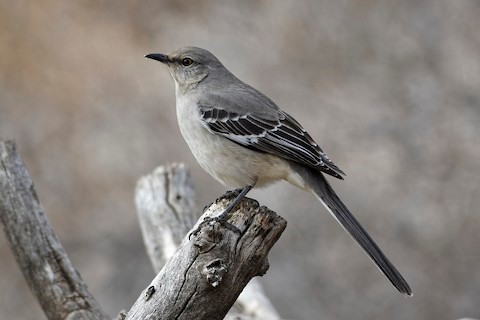
Northern Mockingbird in a typical pose on a typical perch. (Franklin Mountains State Park, Texas; February 2, 2019.) © Don Danko
The upperparts are medium or pale-gray, unmarked. The underparts are whitish and essentially unmarked—but sometimes show faint dark streaks on the flanks.
The wings are mostly blackish with white wingbars and edges, and white patches at the base of the primaries. The tail is most blackish with white outer feathers.

Northern Mockingbird in flight, showing large white wing patches. (Albany, New York; March 31, 2021.) © William Adamczak
The face is marked with a blackish eyestripe and an indistinct whitish eyebrow. The bill is mid-sized (short compared to other thrashers), black, and slightly curved.
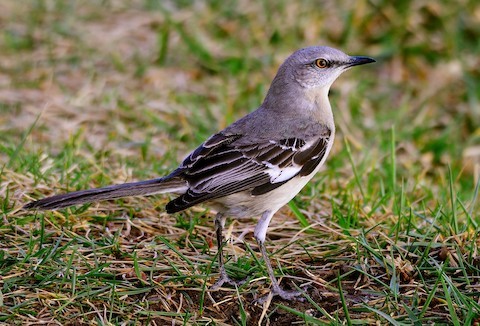
Northern Mockingbird, showing maximum black-and-white contrast. (Frijole Ranch, Guadalupe Mountain National Park, Texas; February 9, 2021.) © Ad Konings
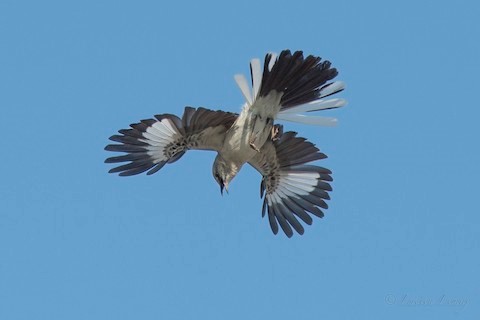
Northern Mockingbird, in flight, showing large white wing patches and white outer tail feathers. (Boul de l’Énergie, Beauharnois, Quebec; July 23, 2019.) © Lucien Lemay
Immatures are browner than adults and have dark spots on the breast.
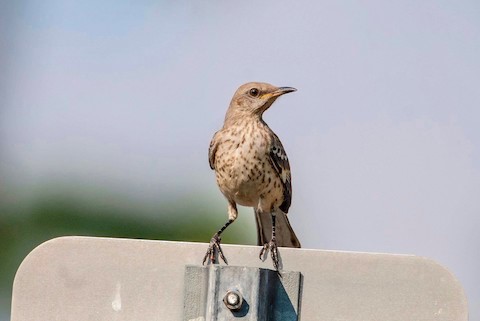
Northern Mockingbird, juvenile showing dark-spotted breast. (Mattie Kelly Park, Destin, Florida; July 29, 2018.) © Andrew Simon
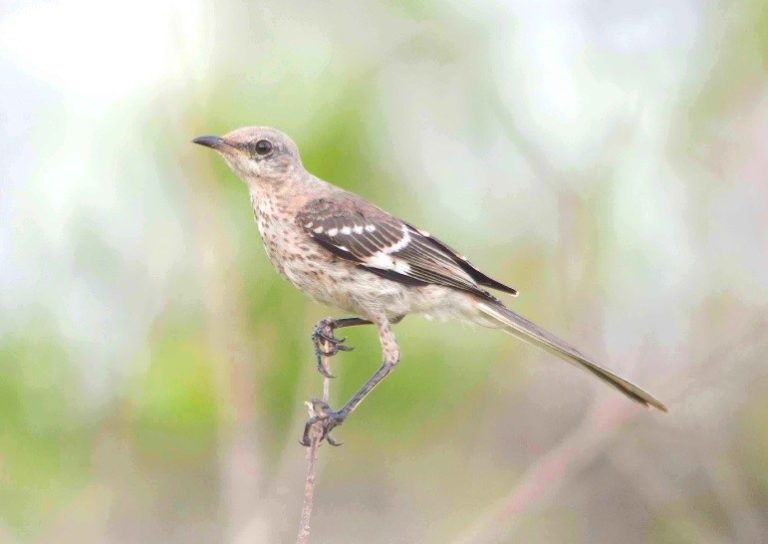
Northern Mockingbird, juvenile—distinguished from Bahama by white patch at the base of the primaries. (Churches Blue Hole, North Andros, Bahamas; August 16, 2013.) © Charlie Skinner
Voice. One of the world’s most accomplished and prolific mimics, it often sings for large portions of the day and night. The quality of its voice is loud, clear, and resonant. Its song typically follows this pattern: a short phrase—often an imitation of another species—is repeated a few times in quick succession, then after a brief pause a different short phrase is similarly repeated, then another, and so on: Calls include a CHEWP! which is repeated at a regular interval:
Notes
Polytypic species consisting of three recognized subspecies.
See below for comparisons of Northern Mockingbird with Tropical and Bahama Mockingbirds.
Cf. Tropical Mockingbird. Northern and Tropical Mockingbirds overlap regularly across much of southern Mexico in Veracruz, Oaxaca, and Chiapas, and likely also in the Yucatán Peninsula and northern Central America—where recent records indicate that Northern probably occurs regularly but has been overlooked due to its similarity to Tropical. Occasional overlap is also possible in the West Indies, as their ranges approach one another in the Leeward Islands. Two U.S. records of Tropical Mockingbird in the 2010s suggest additional potential for overlap due to ship-assisted vagrancy.
Their vocalizations are essentially identical, so by sound alone a person who is familiar with either species would readily confuse them. In areas where both gray mockingbirds may occur, a clear look at the spread wing is necessary and sufficient for positive identification. Northern has large white wing-patches that flash conspicuously in flight, whereas Tropical has mostly dark wings that do not show white patches in flight.

Northern Mockingbird, taking flight, showing diagnostic white wing patches and white outer tail feathers. (Boul de l’Énergie, Beauharnois, Quebec; July 23, 2019.) © Lucien Lemay
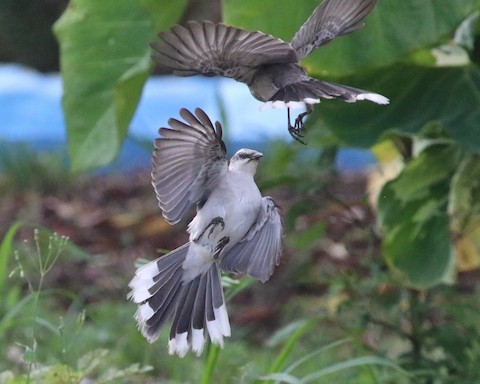
Tropical Mockingbirds in combat, showing white-cornered tail and dark, unmarked wings. (San Pablo Hummingbird Retreat, Sangre Grande, Trinidad; May 9, 2019.) © Jason Fidorra
The tails also differ consistently, but less obviously than the wings. Northern’s two outer feathers are essentially all-white, so it shows broad white sides when spread. Tropical’s tail feathers are broadly tipped with white, more so on the outer feathers, so it appears white-cornered when spread.

Northern Mockingbird, with tail folded and appearing mostly black with a narrow white outer edge—not conclusively identifiable in this photo. (Franklin Mountains State Park, Texas; February 2, 2019.) © Juan Miguel Artigas Azas
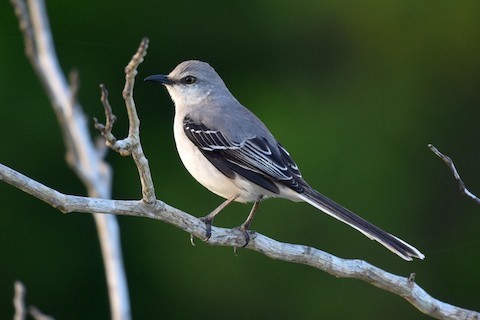
Tropical Mockingbird, showing some white on the wings and narrow white outer edge on the tail—not conclusively identifiable in this photo. (Puerto Morelos, Quintana Roo, Mexico; February 11, 2018.) © Joel Trick
Except for their wings and tails, adults of the two species can appear very similar. Northern tends to appear more neutral gray overall, whereas Tropical tends to show stronger contrast, with blacker wings and whiter underparts. But Tropical is more variable, with some populations or individuals that show richer shades of blue-gray and others that are paler or browner, and some that tend to show more or less pronounced eyebrows, eyestripes, wingbars, and streaks on the flanks.
Cf. Bahama Mockingbird. The Bahama Mockingbird resembles an immature Northern Mockingbird. Northern is common throughout Bahama’s small range, so positive identification of Bahama always entails ruling out immature Northern.
The most reliable difference is the distribution of white on the wings and tail. Northern has large white wing-patches and outer tail feathers, which are obvious in flight, whereas Bahama shows no white on the wings and has white only on the tips of its tail feathers.
Both have dark marks on whitish underparts, but the patterns are reversed. Immature Northern has distinct spots on the breast and fainter spots or streaks on the flanks, whereas Bahama has vague speckles or scallops on the breast and bold streaks on the flanks.
Additional Photos of Northern Mockingbird
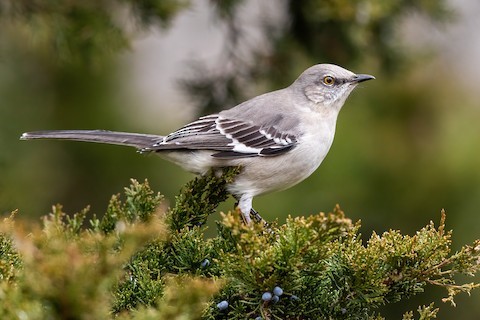
Northern Mockingbird. (Dawes Arboretum, Licking County, Ohio; January 7, 2021.) © Brad Imhoff
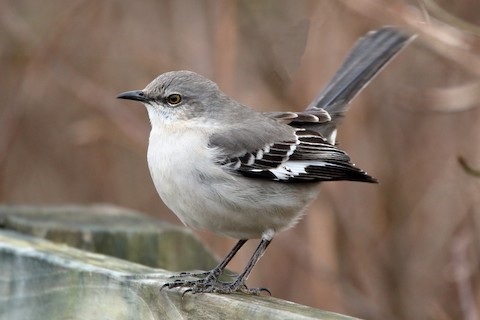
Northern Mockingbird. (Swan Harbor Farm Park, Harford County, Maryland; January 27, 2021.) © John Manger

Northern Mockingbird. (Lake Conestee Nature Preserve, Greenville, South Carolina; October 25, 2019.) © Andrew Simon
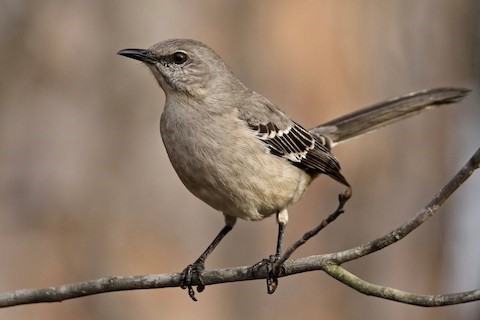
Northern Mockingbird. (Little Rock, Arkansas; February 19, 2018.) © Lance Runion
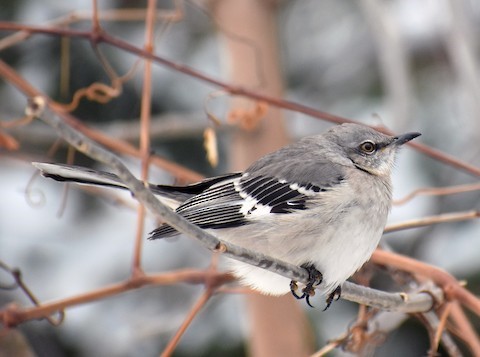
Northern Mockingbird. (Lansing, Michigan; January 20, 2021.) © Amy Hall

Northern Mockingbird, showing clay-whitish underparts. (Riparian Preserve at Water Ranch, Gilbert, Arizona; December 11, 2017.) © Darren Clark

Northern Mockingbird, in a dull, brownish-gray plumage. (Galveston, Texas; April 29, 2021.) © Bob Walker
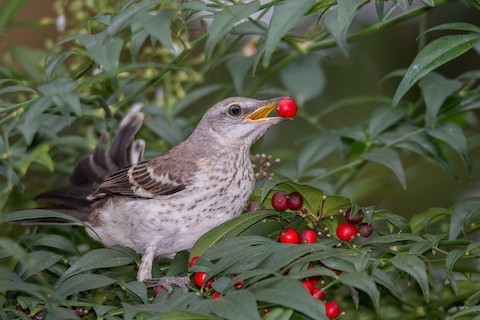
Northern Mockingbird, juvenile. (Houston, Texas; May 20, 2017.) © Terry Woodward
References
Alderfer, J., and J.L. Dunn. 2014. National Geographic Complete Birds of North America (Second Edition). National Geographic Society, Washington, D.C.
BirdLife International. 2017. Mimus polyglottos (amended version of 2016 assessment). The IUCN Red List of Threatened Species 2017: e.T22711026A111233524. https://dx.doi.org/10.2305/IUCN.UK.2017-1.RLTS.T22711026A111233524.en. (Accessed December 24, 2021.)
Brewer, D., and B.K. MacKay. 2001. Wrens, Dippers, and Thrashers. Yale University Press.
eBird. 2021. eBird: An online database of bird distribution and abundance. Cornell Lab of Ornithology, Ithaca, N.Y. http://www.ebird.org. (Accessed December 24, 2021.)
Haynes-Sutton, A., A. Downer, R. Sutton, and Y.-J. Rey-Millet. 1986. A Photographic Guide to the Birds of Jamaica. Princeton University Press.
Howell, S.N.G., and S. Webb. 1995. A Guide to the Birds of Mexico and Northern Central America. Oxford University Press.
Kirwan, G.M., A. Levesque, M. Oberle, and C.J. Sharpe. 2019. Birds of the West Indies. Lynx Edicions, Barcelona.
Pyle, R.L., and P. Pyle. 2017. The Birds of the Hawaiian Islands: Occurrence, History, Distribution, and Status. Version 2 (January 1, 2017). http://hbs.bishopmuseum.org/birds/rlp-monograph/. B.P. Bishop Museum, Honolulu, Hawaii.
Sibley, D.A. 2014. The Sibley Guide to Birds (Second Edition). Alfred A. Knopf. New York.
Svensson, L., K. Mullarney, and D. Zetterström. 2009. Birds of Europe (Second Edition). Princeton University Press.
Xeno-Canto. 2021. Northern Mockingbird – Mimus polyglottos. https://xeno-canto.org/species/Mimus-polyglottos. (Accessed December 24, 2021.)

